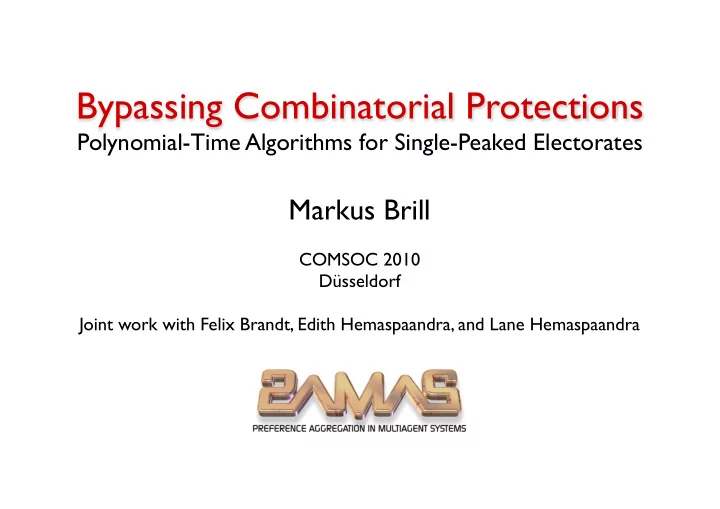

Bypassing Combinatorial Protections Polynomial-Time Algorithms for Single-Peaked Electorates Markus Brill COMSOC 2010 Düsseldorf Joint work with Felix Brandt, Edith Hemaspaandra, and Lane Hemaspaandra
Voting Rules • C = {a,b,c,...} is a finite set of candidates or alternatives • A voting rule f maps a vector V = (v 1 , v 2 , ... , v n ) of votes to a non-empty subset f(V) ⊆ C of candidates ‣ ignores tie-breaking • Ranking-based voting rules ‣ each vote is a complete ranking of the candidates: v i = [b ≻ i a ≻ i c] • Approval-based voting rules ‣ each vote is a set of “approved” candidates: v i = {a,b} Bypassing Combinatorial Protections 2
Voting rules (2) • Ranking-based voting rules ‣ Many rules are defined via pairwise comparisons (majority graphs) ‣ Weak Condorcet winners: all candidates without pairwise defeats ‣ A weakCondorcet rule is a rule that precisely returns all weak Condorcet winners whenever at least one exists ‣ Llull’s rule yields all candidates with minimal number of pairwise defeats ‣ Young, Kemeny, Dodgson, Maximin, Fishburn, Schwartz, ... • Approval voting ‣ yields all candidates with maximal number of approvals Bypassing Combinatorial Protections 3
Swaying Elections • People may try to influence the outcome of an election by ‣ manipulating the voters’ preferences (e.g., bribery, campaigning, strategic manipulation) ‣ changing the election’s structure (e.g., introducing primaries, adding/deleting voters and/or candidates) • All voting rules are vulnerable to at least some of these attacks ‣ But: Attacker’s task may be computationally intractable due to combinatorial challenges (e.g., covering or partition problems) [BTT 1989] • Are such computational protections meaningful in practice? ‣ NP-hardness is a worst-case measure ‣ heuristics that find successful manipulations in “most” instances ‣ approximation algorithms Bypassing Combinatorial Protections 4
Single-Peaked Preferences • What should be the registration fee for COMSOC 2010? ‣ Candidates: € 0, € 25, € 50, € 75, € 100 Jörg Vince Markus € 50 € 75 € 0 € 25 € 100 € 25 € 75 € 50 € 50 € 0 € 25 € 75 € 100 € 0 € 100 0 25 50 75 100 Bypassing Combinatorial Protections 5
Single-Peaked Preferences (2) • Preferences are single-peaked iff there exists a linear ordering over C such that if b lies between a and c, then (a ≻ i b ⇒ b ≻ i c) for all voters i ‣ natural variant for approval votes: approved candidates form an interval ‣ Popular model in political science - left-right political spectrum ‣ Singled-peakedness can be checked in polynomial time [BT 1986] 0 25 50 75 100 ‣ weak Condorcet winners always exist (nice characterization in terms of median voters) Bypassing Combinatorial Protections 6
Bribery • Is it possible to bribe at most k voters such that p wins? ‣ NP-complete for approval voting - reduction from X3C [FHH 2009] ‣ Theorem: For single-peaked electorates, approval bribery is in P v 1 v 2 v 3 v 4 v 5 sc’(p)=sc(p)+k v 6 sc(c)>sc’(p) v 7 c Bypassing Combinatorial Protections 7
Bribery • Is it possible to bribe at most k voters such that p wins? ‣ NP-complete for approval voting - reduction from X3C [FHH 2009] ‣ Theorem: For single-peaked electorates, approval bribery is in P ‣ NP-hard for Llull’s rule and [FHH 2009] Kemeny’s rule ‣ Theorem: For single-peaked electorates, this problem is in P for all weakCondorcet rules - e.g., Fishburn, Maximin, Young, Llull, Kemeny, Schwartz, Nanson , etc. Bypassing Combinatorial Protections 8
Control • Is it possible to add/delete k voters such that p wins? ‣ NP-hard for Kemeny’s rule and Young’s rule ‣ Theorem: For single-peaked electorates, both problems are in P for all weakCondorcet rules • Can the set of voters be partitioned into two subsets (primary elections) such that p wins the final election? ‣ NP-complete for Llull’s rule [FHHR 2009] 2x 1x 2x 1x ‣ Theorem: For single-peaked electorates, b a c a this problem is in P for all weakCondorcet a b a c rules c c b b Bypassing Combinatorial Protections 9
Manipulation • Constructive coalition weighted manipulation problem: Is it possible to set the preferences of manipulative voters such that p wins? • We completely characterize all scoring rules where CCWM is in P or NP-complete for single-peaked electorates, respectively Bypassing Combinatorial Protections 10
Conclusion • It has been shown in previous work that various manipulative attacks on voting rules are computationally intractable • In many realistic settings preferences may be assumed to be single-peaked • The preference profiles constructed in many hardness proofs are so intricate that they cannot be realized by single-peaked electorates • Good news: Young, Kemeny, and Dodgson winners can be computed in P for single-peaked electorates Bypassing Combinatorial Protections 11
Recommend
More recommend